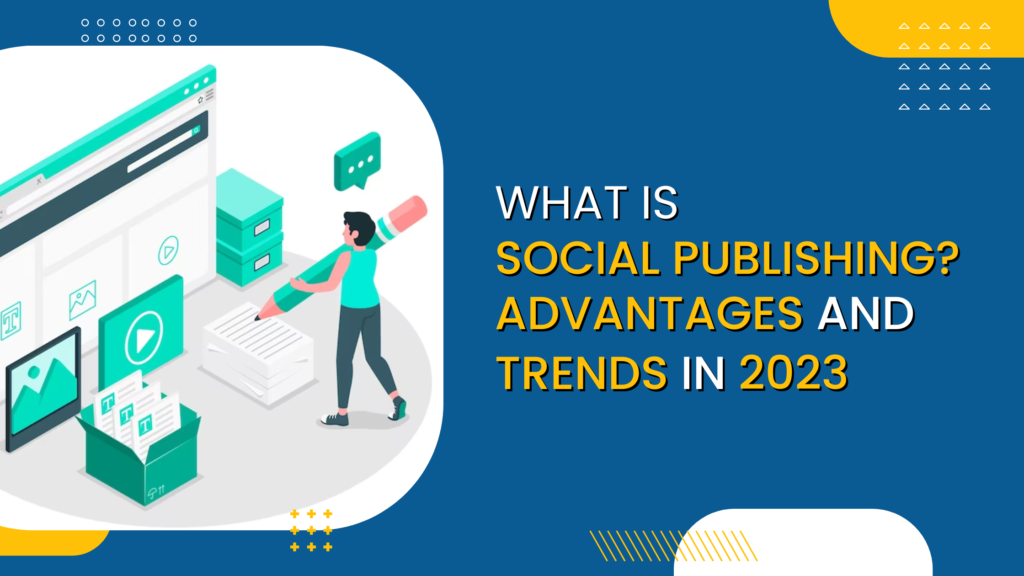Content creation is paramount for any business. But what comes after posting your content is just as important. Brands need to engage audiences.
Social publishing opens an omnipresent channel for instant feedback. It is a goldmine of instant information, feedback, and everything else that contributes to the growth of a brand and building strong client relationships.
Let’s learn more about it!
What is social publishing?
Social publishing is a way of sharing content. This will enable people to interact with your brand and others. The interactions can be in the form of comments they leave on your brand’s account, the emails they reply to, the videos they share, and so much more. Social media management is so much more than brands posting content. It’s also about building an audience and generating organic leads for your business. Brands can no longer afford to post long monologues and scoot out of the scene. In today’s day and age, the only content that endures is the one that starts a conversation. Every post that you share on your social media platforms and blogs should focus on building audience confidence.Social publishing = Interacting with your audience
Platforms, algorithms, user preferences, and communication practices are changing at lightning speed. But the gist of the game remains the same.- The audience wants to be cared for.
- They want their queries answered.
- They want to be served.
7 best ways to take advantage of social publishing:
1. Optimize Your Social Media Profile
Make your social media profiles welcoming, attractive, and streamlined. Additionally, the profile should also be interactive. It should be the best summary of your mission and vision statement. This covers your brand’s profile picture, bio, links, and contact information.2. Design a Social Media Style Guide and Stick To It
It is important to have a consistent and coherent message across your social media platforms. If your content team is diverse, you are bound to miss out on having a jumbled-up and confusing social media strategy. It doesn’t take much to confuse the average customer. Inconsistent messaging can cost your business money and leads. With a style guide in your hands, you can present your ideas to the world. You can build a readership that is bound to understand the key takeaways from your social media postings.3. Customize your content
Once you have settled on a style guide, it’s time to customize the content as per your brand’s design, color palette, and core values. Customizing content is an important part of your inbound marketing strategy. It allows you to be instantly recognizable from the crowd. An integral part of your social publishing strategy in 2023 is to understand which platform is best for your publishing. By doing so, you can give your audience a better chance to connect with you. For example, it makes no sense for you to post long-form posts on Twitter. Those should go on Facebook.4. Share Relevant and industry-specific Content
The golden rule of creating an interactive and loyal audience online is walking the fine line between 90/10. 90% of your content should be educational and informative knowledge about your industry. And 10% of your content should be promotional of your products and services. It’s crucial to publish content that is relevant to your industry. This way, readers gain benefits and get the urge to contribute to the conversation. This also allows your readers to share stuff with you and your audience that wasn’t in your knowledge pool before – A win-win.5. Publish consistently
It goes without saying that you must be consistent with your social media posting schedule. The best way to build an audience is to keep showing up for them. There’s nothing that turns off customers more than inconsistency. Many businesses start with a bang but give up halfway. Lack of consistency is also considered a sign of a lack of strategy and seriousness. Once consumers know that your business keeps tabs on relevant content and desires to stay engaged, it increases the likelihood that they will want to be engaged with your business.6. Include user-generated content
User Generated Content (UGC) is content that you post that wasn’t created by you. It is sourced from the public. Social campaigns are seeing an uptick of 50% more engagement with UGC. UGC can be in the form of a story repost, reblog, retweet, clipped post, pinned comment, or quote from an influencer. An interactive comment section and websites filled with testimonials are all UGC. These assure your brand’s reliability and worth in front of the audience. They also affirm their faith in your business.7. Learn the lingo of your audience
Did you know that more than 700 million emojis are used daily on Facebook? If the bread and butter of your online business is Facebook, then you must learn the platform’s language. Memes, fanciful data visualization tools, and emoji-based emails are all the rage right now. Visual communication is not dying out anytime soon. Business owners must adapt to this change. How they communicate with a generation that “speaks” through memes matters.4 The Scheduling Trends of Social Publishing 2023
Here are some of the most notable scheduling trends that we can expect in 2023.-
Consistency will be rewarded
-
Businesses will move toward efficiency
-
Organizing content will be prioritized
-
Brands will take swings at viral content
Tips for Building The Foundation of Social Publishing
You can save time, resources, and plenty of headaches by automating manual tasks and anticipating the needs of your audience. Here’s how you can streamline your publishing team’s workflow:- Sign up for scheduling tools for your social media content across all major platforms.
- Automate the process of collecting data analytics on spreadsheets using social listening tools.
- Sign up for audience management tools such as HypeFury.
- Auto-generate your Instagram captions and YouTube descriptions
- Set all your monetization settings to default.
- Use a social media scheduling platform as a part of your social media management strategy.

